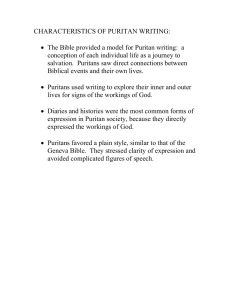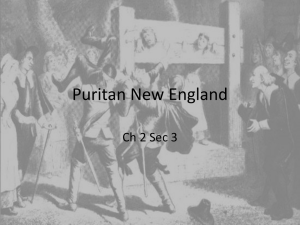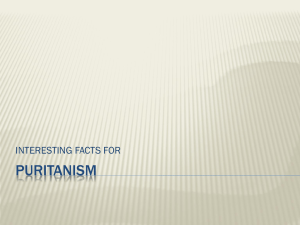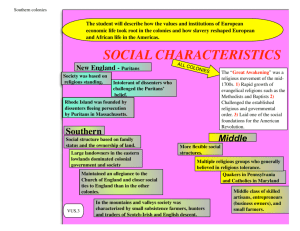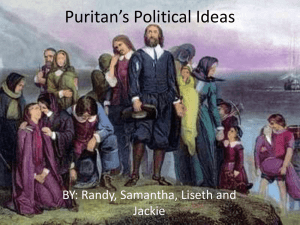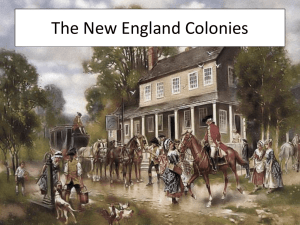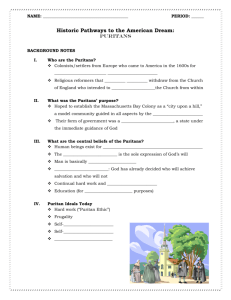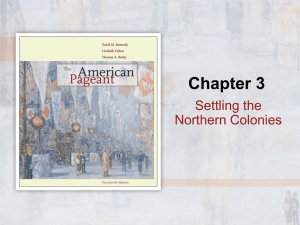Puritan stuff to work on
advertisement
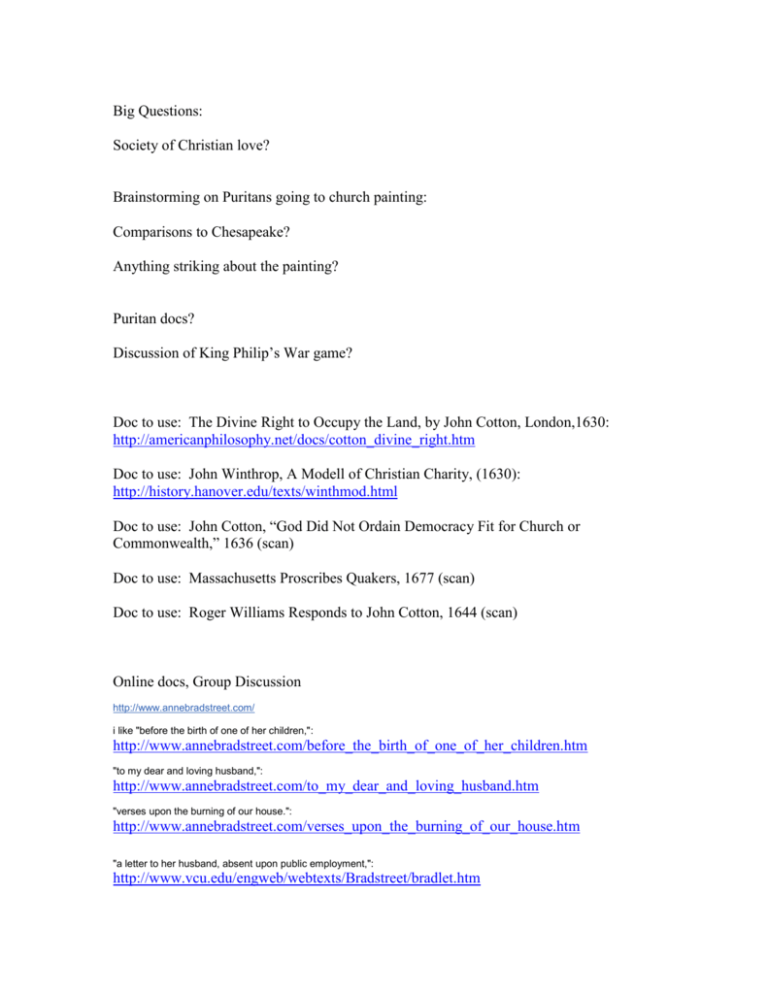
Big Questions: Society of Christian love? Brainstorming on Puritans going to church painting: Comparisons to Chesapeake? Anything striking about the painting? Puritan docs? Discussion of King Philip’s War game? Doc to use: The Divine Right to Occupy the Land, by John Cotton, London,1630: http://americanphilosophy.net/docs/cotton_divine_right.htm Doc to use: John Winthrop, A Modell of Christian Charity, (1630): http://history.hanover.edu/texts/winthmod.html Doc to use: John Cotton, “God Did Not Ordain Democracy Fit for Church or Commonwealth,” 1636 (scan) Doc to use: Massachusetts Proscribes Quakers, 1677 (scan) Doc to use: Roger Williams Responds to John Cotton, 1644 (scan) Online docs, Group Discussion http://www.annebradstreet.com/ i like "before the birth of one of her children,": http://www.annebradstreet.com/before_the_birth_of_one_of_her_children.htm "to my dear and loving husband,": http://www.annebradstreet.com/to_my_dear_and_loving_husband.htm "verses upon the burning of our house.": http://www.annebradstreet.com/verses_upon_the_burning_of_our_house.htm "a letter to her husband, absent upon public employment,": http://www.vcu.edu/engweb/webtexts/Bradstreet/bradlet.htm Issue: purity and worldliness Use of Bradstreet poem (student insight) – rejection of worldly goods vs. hard work and earthly success Images of war, brutality Images of New England town layout Things to include: War and purification: precedent in European wars, followed by wars against Native Americans Witches Not just self-sufficient farmers Involved in Atlantic trade, triangle trade, ports, markets, consumer earthly goods Purifying society; perfectionism on earth = Reform movements Reading Notes Puritans adapted Calvinism – God is reasonable, salvation not random Lifestyle is one indicator if one is saved, so root out sinfulness, live good life, and one can be fairly sure one will be saved Critical of English society as well as Anglican Church: sinfulness, crime, commercial nature Wanted to create society with Christian love Attacked by Charles I: lost jobs, right to worship – push to MA John Winthrop, City Upon a Hill – covenant with God God’s covenant with Abraham If they obeyed God’s command, they would be blessed If they succeeded, then they had covenant: If they got to N.E. safely, then God supported them; only lost 1 ship out of 100 Puritan family: center of Puritan life; patriarchy; women expected to marry and have children; unmarried looked down on, suspect; widows expected to remarry Problems related to religion Exclusivity Anne Hutchinson Came to MA in 1634, was a midwife and educated by father Held religious meetings in her home and discussed sermons of ministers Accused of heresies: teaching men, evaluating ministers’ beliefs, antinomianism (belief that God was talking directly to individuals) Banished from MA Roger Williams Thought more dangerous b/c he was a minister Disagreed with church leadership on relationship between church and state Believed in toleration – people shouldn’t be forced to join or attend church Exclusion wrong Disagreed on treatment and relations with Native Americans Williams believed N.A. deserved respect; relations of peace; bargaining or buying of land Williams banished from MA in 1636; founded R.I. in 1644 Quakers and other non-Puritans were repressed Quakers: God spoke directly to individuals; equality of religious experience; women were active participants; jailed, repressed, and even executed – Mary Dyer Toleration Act of 1689 – England passed Act that colonies had to accept religious toleration of other sects Problem of declension – 2nd and 3rd generations not as religious Halfway covenant, 1662 – children of members could participate in church – way of appealing to younger generations to become involved Everyone required to attend church, pay taxes to church Not everyone a member; only those thought to be saved Decided before church leaders Advantage of being a member was right to vote Govt. founded to do God’s law, not people’s good Early town meetings were consensus b/c God’s will could not be split – this broke Down eventually Economics Competency Land hungry – conflict with native Americans; Much land already open b/c of native American work, then disease Rocky ground, wheat, corn, grains, fruits, shipping (trade with W. Indies, Chesapeake tobacco) First couple of generations were middle-class, some rich merchants Trouble on City on a Hill 3 conflicts: with England, with Native Americans, class conflict Population dispersal after 1630s Religious dissenters Relationships with English Crown and Economy Mercantilist goals of England – raw materials, colonies should buy Finished goods Navigation Acts in 1660s to enforce mercantilism: English ships, sailors, Goods to and from England But N.E. didn’t have much raw materials or plantation economy N.E. had shipping which competed with British ships, got around laws, Traded with competing nations N.E. wanted more free trade, not mercantilism Puritans not obeying Navigation Acts, so England taxed them and reorganized govt.; created Dominion of New England from Maine to NJ; got rid of colonial assemblies and enforced religious toleration During English Civil War , Glorious Revolution, 1688-89, Puritans retook colonies from Anglicans/Royalists But with reinstatement of monarchy, English asserted tighter control, creating Royal Colony of MA, new navigation acts and taxes Later in 1715 Parliament took control of colonies, virtual representation MA and other New England Colonies had same structure, but actual Representation Outcome?: Role in Atlantic trade = worldly profits, sinful trades (slavery, rum) Relations with Native Americans Watch PBS We Shall Remain, After the Mayflower: http://www.pbs.org/wgbh/amex/weshallremain/the_films/episode_1_trailer Pequot War, 1637 Context: prior diseases decimated tribes, power vacuum; competition among tribes for influence with Europeans for fur trade Mohegans allied with English; Pequots with Dutch Attacks on Pequot traders; predatory Euro. Traders broke rules of reciprocity; competition and attacks between Indians and allies Conflict over land in CT river valley Pequots already had more positive relationships with Dutch and French fur Traders – reciprocal relations of trade But Puritans wanted land and permanent settlement Narragansetts and Puritans had closer relations, so Puritans got Ns to attack Ps Puritans not happy with progress of war, so wiped out Pequots Used Bible to justify war; test of their will; Bible justified Israel’s decimation of other tribes too Mystic: Puritan leaders called out the militia and enlisted dissident Pequots and some 500 Narragansetts to help attack a Pequot fort on the Mystic River which sheltered most of the Pequot women and children. The English surrounded the fort, set fire to it, and killed many of the Pequot people who tried to escape. Some 400 hundred died. The Puritan then hunted down the Pequot men in detail. The few survivors were handed over to the native allies of the English as payment for their services. Many were sold into slavery. King Philip’s War (1675-76) Chief of Wampanoags – unhappy with treatment of N.A.; punishment for Crimes; land-hungry expansion; bad treaties that ripped off N.A. K.P. convinced Ws and Ns to unite to fight whites; got within 20 miles of Boston; defeated several towns Of 90 puritan towns, 52 attacked 1/7 of puritan towns destroyed - Took 40 years to rebuild and resettle lands puritans had before war Philip reached out to Mohawks to join war against Puritans, but instead Ms attacked Ws and Ns Wampanoags and Narragansetts were defeated b/c of Mohawk attacks Mohawks and Iroquois became leading intermediaries in trade with whites And N.A. King Philip's War http://ourpluralhistory.stcc.edu/firstpeoples/King%20Philips%20War.html War between European colonists and the indigenous people of New England broke out in 1675. After two years of fighting and thousands killed in Massachusetts, the war ended with the death of Wampanoag leader Metacomet, called King Philip by the English. During King Philip's War, the town of Springfield was burned to the ground. The arrival of European colonists in North America uprooted native communities and decimated the native population. Though some of the native groups of the Connecticut River Valley established commercial exchange with the Europeans, relations soured as more and more settlers arrived and encroached further on the farming and hunting grounds of the indigenous people. For almost sixty years before the war, the Wampanoags of southern New England lived in relative peace with the European settlers. An epidemic in 1616 devastated the Wampanoags, who then turned to the Europeans for protection against the rival Narragansetts. The Wampanoags taught the colonists about local food crops and farming techniques. The European population grew, claiming more of the Indians' crop and village land, while the Wampanoag population declined. By the late 1670s, the Wampanoags were treated as a subject people, and Metacomet began to organize a fight for the group's survival. In the spring of 1675, Metacomet and his fighters launched a series of attacks against European villages, farms, and travelers across Massachusetts. Incited by Metacomet's successes, the Hadley sachem Wequogan began planning an attack on Springfield. In early October 1675, Wequogan and his warriors gathered on a palisaded hilltop near what is now the Springfield-Longmeadow line. Forewarned of the attack, townspeople sought refuge in several fortified houses, including John Pynchon's brick house. Pynchon was away with the militia in Hadley, and word of the attack came too late for the troops to make it back to Springfield. The townspeople awoke to smoldering ruins. Most of the buildings in town had been burned, and the saw mill and grist mill were destroyed. Sporadic Indian attacks continued, and Springfield residents passed the winter in a state of siege. Provisions laid up in barns on the west side of the river provided food, but the work of repairing buildings and grinding grain had to be done by hand. Nearly 600 Europeans died defending the Massachusetts colony, and nearly 8,000 Indians were killed, enslaved, or made refugees. Two musket shots killed Metacomet in 1677, leading the native warriors to surrender. Isolated fighting between the First Peoples of the Connecticut River Valley and European settlers continued for almost 100 years. Religious schism Tendency for schism and criticism of leadership Great Awakening, George Whitefield – 20,000 in Boston, 1739 Old and New Lights Jonathan Edwards Tendency towards reform and perfection – reform movements Economic growth in 18th century Consumer revolution – N.E. shipping, trade with England Growth in w. indies slave economies drove whole Unification of economy, tastes, and bonds between colonies Tea drinking Problem of declension from religious focus and competency Less land available Opportunities for wealth through commerce Belief in hierarchical society anyway, so justified differences in wealth and power Conflicted with P beliefs in community, equality, duties of rich to poor Wealthy started own churches Problems of change and declension were context of height of witch trials, contributed to them, along with war, gender roles Puritan beliefs in witches not unique, but more focus on outcasts, women, poor Focus on conformity, correct women’s roles in society Constant surveillance, rumors in P life – conformity to values and rules Heightened surveillance b/c of war and commercial development Tituba, crystal ball, hysterical young women accused T of being witch Two Sarahs (Goode and Osgoode) accused of casting spells, one typical outcast, the other an argumentative woman T confessed and accused dozens of others 48 people claimed spells put on them 200 accused; 50 confessed – why? Confessors wouldn’t be executed, but had to rat out teachers of witchcraft

